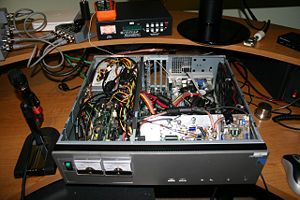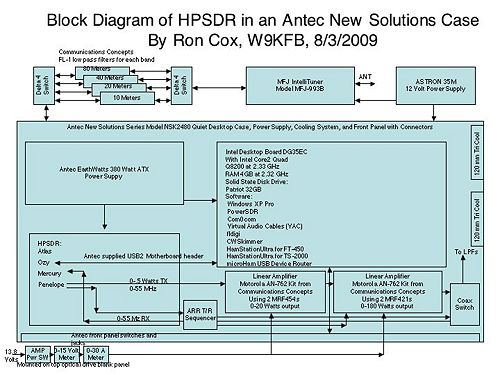Difference between revisions of "A complete HPSDR transceiver"
(started page "== How to Build a Complete HPSDR Transceiver ==") |
(added "enclosure" section) |
||
| Line 9: | Line 9: | ||
A totally integrated transceiver with an integrated computer, audio amplifier, speaker, HPSDR components, and 10 to 50 watts of power output. Not included would be the keyboard, mouse, flat panel screen, and antenna tuner. You could compare the proposed rig to commercial rigs such as the Flex 3000, TS-B2000, FT-2000, FT-950, or Ten Tec Pegasus. The transceiver must be mechanically and electrically secure so that one would not hesitate to take one to a field day exercise or a DXpedition as a primary rig. | A totally integrated transceiver with an integrated computer, audio amplifier, speaker, HPSDR components, and 10 to 50 watts of power output. Not included would be the keyboard, mouse, flat panel screen, and antenna tuner. You could compare the proposed rig to commercial rigs such as the Flex 3000, TS-B2000, FT-2000, FT-950, or Ten Tec Pegasus. The transceiver must be mechanically and electrically secure so that one would not hesitate to take one to a field day exercise or a DXpedition as a primary rig. | ||
| + | |||
| + | === Enclosure === | ||
| + | |||
| + | It may be possible to build the rig I have in mind in the HPSDR's Pandora's box. I think it is very possible to do so if you are using a laptop computer can keep the RF powerout requirements to that needed for narrow band modes such as PSK31 and CW. I am building such a rig, but two other rigs I have built came closer to meeting the specifications above and I think with this experience, I can meet the goals set (see[[Image:IMG 1129.jpg|thumb|300px|W9KFB's HPSDR rig interior ]] and [[Image:Slide1.jpg|thumb|500px|Block diagram of W9KFB's HPSDR rig]]). | ||
Revision as of 08:45, 8 August 2009
This section provides an example of how to build your own transceiver using HPSDR components and other available hardware and software. It concludes with test measurements that compare the finished transceiver to other commercially available high end transceivers.
How to Build a Complete HPSDR Transceiver
By Ron Cox, W9KFB (with help from the HPSDR group who made all this possible)
Specifications
The goal in this section will to be build and operate the Highest Performance Amateur Radio Transceiver that can be assembled using components documented on this wiki. Specifically in one case/enclosure, the following is expected:
A totally integrated transceiver with an integrated computer, audio amplifier, speaker, HPSDR components, and 10 to 50 watts of power output. Not included would be the keyboard, mouse, flat panel screen, and antenna tuner. You could compare the proposed rig to commercial rigs such as the Flex 3000, TS-B2000, FT-2000, FT-950, or Ten Tec Pegasus. The transceiver must be mechanically and electrically secure so that one would not hesitate to take one to a field day exercise or a DXpedition as a primary rig.

